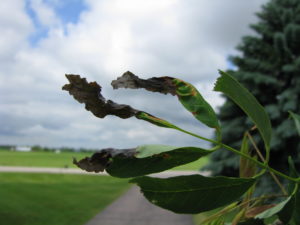Mike Hillstrom, forest health specialist, Fitchburg, Michael.Hillstrom@wisconsin.gov, 608-513-7690
It’s nearly summer and the usual cast of disease characters are on the scene following wet spring conditions. Rhizosphaera needlecast and other needle diseases impacting spruce continue to be a major concern for landowners and homeowners. Diseases in hardwoods are also popping up. For more information on needle and leaf diseases affecting trees in Wisconsin and resources to learn more, click below to read full article.

Spruce trees impacted by Rhizosphaera needlecast.
Non-native blue spruces are the most severely impacted by needle diseases, particularly Rhizosphaera needlecast, but wet weather in the last two years has also caused disease build-up in native white spruce. In southern Wisconsin, wet, heavy snow in late April knocked diseased needles off infected spruces to dramatic effect in some instances.
Increasing air circulation is key to management. Symptoms of needle diseases on spruce trees usually progress from inside to outside and bottom to top. Pruning lower branches, which is best when done from October to March, keeping grass underneath short and thinning overcrowded trees will all help prevent disease issues. On infected trees, prune out infected branches and rake up and dispose of diseased needles under the trees. Applying a fungicide can further help control spruce needles diseases. For more information see the Rhizosphaera needlecast webpage from UW-Extension.
As trees continue to leaf out over the next few weeks, forest health staff anticipate seeing a rise in other common spring tree diseases that affect hardwoods. Anthracnose infection has been very common in recent years. Symptoms appear as patches of brown, dead leaf tissue which may cause leaves to curl or shrivel up as damage progresses. Anthracnose impacts maples, oaks and other hardwood species but the effects are often most dramatic on ash. Ash infected in early spring often drop the diseased leaves resulting in trees with very thin-looking crowns. Frost damage can contribute to this early leaf drop as well. No need to worry, the trees will send out new leaves as needed. Lots of other leaf diseases can affect hardwoods, but the symptoms often look worse than they actually are with most trees recovering by early summer.

Brown, dead areas of leaf tissue on ash leaves caused by anthracnose.
There are many other needle diseases that impact conifers. Some can be serious and should be properly diagnosed and treated. If you own several acres of land and are concerned about the health of your trees, contact your local forest health specialist. If you have a few trees in your yard, contact your local county extension office or find a certified arborist. Yard tree samples can also be brought or mailed to the University of Wisconsin Plant Disease Diagnostic Clinic. Collection and storage instructions can be found in this publication. Follow instructions for evergreen branches if you are submitting samples from a conifer.
